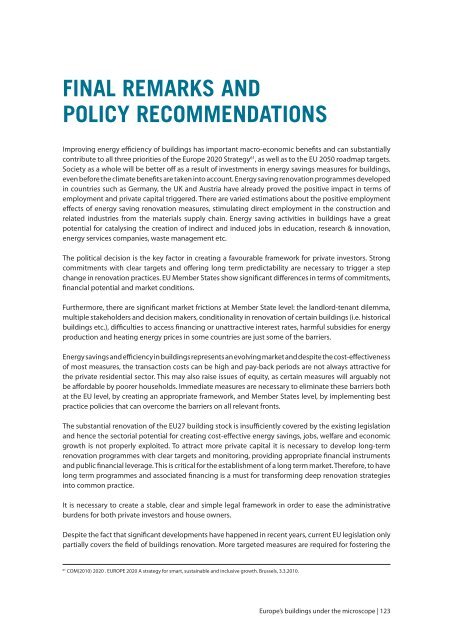BPIE: Europe's buildings under the microscope - PU Europe
BPIE: Europe's buildings under the microscope - PU Europe
BPIE: Europe's buildings under the microscope - PU Europe
Create successful ePaper yourself
Turn your PDF publications into a flip-book with our unique Google optimized e-Paper software.
Final remarks and<br />
policy recommendations<br />
Improving energy efficiency of <strong>buildings</strong> has important macro-economic benefits and can substantially<br />
contribute to all three priorities of <strong>the</strong> <strong>Europe</strong> 2020 Strategy 61 , as well as to <strong>the</strong> EU 2050 roadmap targets.<br />
Society as a whole will be better off as a result of investments in energy savings measures for <strong>buildings</strong>,<br />
even before <strong>the</strong> climate benefits are taken into account. Energy saving renovation programmes developed<br />
in countries such as Germany, <strong>the</strong> UK and Austria have already proved <strong>the</strong> positive impact in terms of<br />
employment and private capital triggered. There are varied estimations about <strong>the</strong> positive employment<br />
effects of energy saving renovation measures, stimulating direct employment in <strong>the</strong> construction and<br />
related industries from <strong>the</strong> materials supply chain. Energy saving activities in <strong>buildings</strong> have a great<br />
potential for catalysing <strong>the</strong> creation of indirect and induced jobs in education, research & innovation,<br />
energy services companies, waste management etc.<br />
The political decision is <strong>the</strong> key factor in creating a favourable framework for private investors. Strong<br />
commitments with clear targets and offering long term predictability are necessary to trigger a step<br />
change in renovation practices. EU Member States show significant differences in terms of commitments,<br />
financial potential and market conditions.<br />
Fur<strong>the</strong>rmore, <strong>the</strong>re are significant market frictions at Member State level: <strong>the</strong> landlord-tenant dilemma,<br />
multiple stakeholders and decision makers, conditionality in renovation of certain <strong>buildings</strong> (i.e. historical<br />
<strong>buildings</strong> etc.), difficulties to access financing or unattractive interest rates, harmful subsidies for energy<br />
production and heating energy prices in some countries are just some of <strong>the</strong> barriers.<br />
Energy savings and efficiency in <strong>buildings</strong> represents an evolving market and despite <strong>the</strong> cost-effectiveness<br />
of most measures, <strong>the</strong> transaction costs can be high and pay-back periods are not always attractive for<br />
<strong>the</strong> private residential sector. This may also raise issues of equity, as certain measures will arguably not<br />
be affordable by poorer households. Immediate measures are necessary to eliminate <strong>the</strong>se barriers both<br />
at <strong>the</strong> EU level, by creating an appropriate framework, and Member States level, by implementing best<br />
practice policies that can overcome <strong>the</strong> barriers on all relevant fronts.<br />
The substantial renovation of <strong>the</strong> EU27 building stock is insufficiently covered by <strong>the</strong> existing legislation<br />
and hence <strong>the</strong> sectorial potential for creating cost-effective energy savings, jobs, welfare and economic<br />
growth is not properly exploited. To attract more private capital it is necessary to develop long-term<br />
renovation programmes with clear targets and monitoring, providing appropriate financial instruments<br />
and public financial leverage. This is critical for <strong>the</strong> establishment of a long term market. Therefore, to have<br />
long term programmes and associated financing is a must for transforming deep renovation strategies<br />
into common practice.<br />
It is necessary to create a stable, clear and simple legal framework in order to ease <strong>the</strong> administrative<br />
burdens for both private investors and house owners.<br />
Despite <strong>the</strong> fact that significant developments have happened in recent years, current EU legislation only<br />
partially covers <strong>the</strong> field of <strong>buildings</strong> renovation. More targeted measures are required for fostering <strong>the</strong><br />
61<br />
COM(2010) 2020 . EUROPE 2020 A strategy for smart, sustainable and inclusive growth. Brussels, 3.3.2010.<br />
<strong>Europe</strong>’s <strong>buildings</strong> <strong>under</strong> <strong>the</strong> <strong>microscope</strong> | 123
















